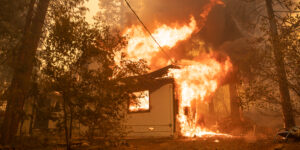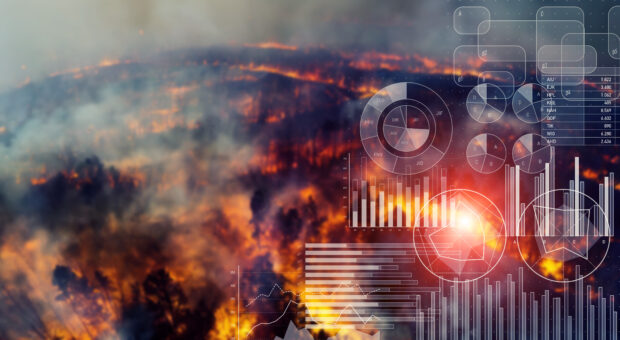Few Western states and counties with the highest wildfire risk are using sound regulatory approaches backed by consistent enforcement, according to a new report released jointly by the Insurance Institute of Business & Home Safety (IBHS), the National Fire Protection Association (NFPA) and Verisk.
The report, “Living with Wildfire,” examined community vulnerability and wildfire readiness around the wildland-urban interface (WUI) in 13 Western states.
Separating wildfire safety from traditional building codes and a lack of clear guidance on how to integrate them has resulted in limited use by state and local officials.
“California and Utah are the only Western states with uniformly enforced statewide codes specifically addressing wildfire exposures to residential and commercial properties,” said IBHS Managing Director for Standards & Data Analytics Dr. Ian Giammanco. “A few local jurisdictions have proactive approaches, but they stand in sharp contrast to the majority of counties and local communities that largely fail to comprehensively address wildfire risks through building codes and up-to-date planning activities.”
An estimated 45 million structures are at risk nationwide, with around 14 million structures located in 13 Western states, according to Verisk’s Wildfire Risk Analysis.
Population growth combined with inadequate fuel management practices and the limited use and enforcement of WUI building codes has increased wildfire risk, a situation also exacerbated by climate change.
Despite a federal mandate requiring Community Wildfire Protection Plans in areas adjacent to national forests and rangelands, the agencies indicate that one in four high-risk counties studied lacked plans to adequately address the risk.
Data showed that seventeen percent of the counties examined had not updated their plans in over 10 years.
“NFPA, IBHS and Verisk, among many organizations, have long recognized that implementing and enforcing statewide policies play a critical role in reducing wildfire’s impact on people and property,” said Michele Steinberg, director of the NFPA wildfire division. “This report confirms that the majority of states and jurisdictions at highest risk to wildfire aren’t putting the needed requirements and measures in place to effectively mitigate wildfire risks. Sadly, as long as they don’t, communities will continue to pay a high price in the wake of wildfires.”
The study also shows there is no correlation between the amount counties spend on wildfire-related activities and the use of WUI codes or community wildfire preparedness plans in those counties.
“Verisk supports coordinated research and education to help reduce the scope and severity of wildfire losses,” said Dr. Arindam Samanta, director of product management, Verisk Underwriting Solutions. “This collaboration represents another step in Verisk’s efforts to help insurance carriers manage wildfire risk and to build stronger, more resilient communities.”
Wildfire disasters impact lives and property, the safety and effectiveness of the fire service, and the ability of businesses and local governments to recover and the insurance industry’s ability to provide a financial safety net for people to rebuild their lives and livelihoods, the joint report stated.
The report noted local fire departments serve as a vital and trusted communications link for communities to understand how to reduce risk, but support for inspection and outreach programs varies across the West because local fire departments often lack training and financial resources.





















 InsurTech Profile: Optimalex’s AI Tools ‘Co-Pilot’ Alongside Human Expertise
InsurTech Profile: Optimalex’s AI Tools ‘Co-Pilot’ Alongside Human Expertise  Executives on the Move at AIG, White Mountains, Vermont Mutual
Executives on the Move at AIG, White Mountains, Vermont Mutual  Progressive Gains as Drivers Shop Around for Auto Insurance—Again
Progressive Gains as Drivers Shop Around for Auto Insurance—Again  New Atlantic Hurricane Forecast Calls for 33 Named Storms
New Atlantic Hurricane Forecast Calls for 33 Named Storms 



